Whales and whale watching in Iceland: a definitive guide
Why go whale watching in Iceland?
Iceland is a cetacean hot-spot. Twenty-three species of whales, dolphins and porpoises have been recorded in these seas – that is about one quarter of all the known species in the world!
If you want to learn more about these many different kinds of whales, we recommend a visit to Whales of Iceland, where you can experience the true scale of these gentle giants as if you were swimming alongside them. Several of these twenty-three species are not seen very often – some are only occasional visitors to Iceland, and some are just very shy – so this is a great way to get to know them all.
But of course, there is no better way to encounter whales and dolphins than to see them in their natural environment.
Deciding where, when, and how to go whale watching can be tricky. There are a lot of questions involved in planning a trip – but don’t worry, because we have the answers! This guide covers everything you need to know about whales and whale watching in Iceland, including:
- What makes these seas so full of marine life
- The most commonly-sighted whales and dolphins around Iceland; and
- Some tips on the best places to see them all.
Why are there so many whales around Iceland?
Seasons in polar and sub-polar regions are extreme. In winter, there is very little light, which means that phytoplankton – microscopic aquatic plants that make their food from sunlight – cannot survive. Phytoplankton are the base of every food chain in the ocean. Without them, there is little food available for any marine animal.
But in summer, days are long, with almost constant sunlight! In these conditions, phytoplankton flourish: growing into colossal phytoplankton blooms that can stretch over hundreds of miles of water.
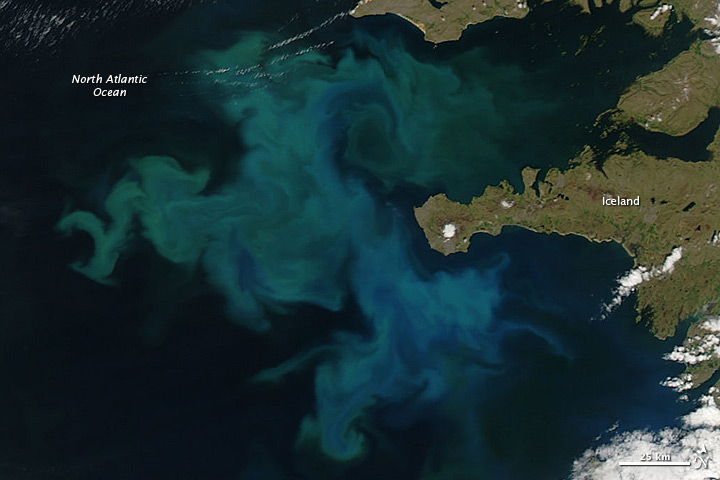
The swirling blue-green area in this satellite image is a phytoplankton bloom – this one stretches about 150km down the west coast of Iceland. Image from NASA.
Very small animals called zooplankton time their life cycle so that they emerge at the peak of the phytoplankton blooms. The zooplankton rely on phytoplankton for food, but they themselves are food for many, many other animals!
This intense seasonal ‘boom and bust’ cycle means that Icelandic seas are teeming with life during summertime, and this attracts some of the largest animals on Earth.
What whales can you see around Iceland, and where is the best place to see them?
Common minke whale (Balaenoptera acutorostrata)
The common minke whale is the smallest baleen whale to be found in Iceland. True to their name, they are most numerous marine mammal in Icelandic coastal waters during summer.
Their distribution in this part of the North Atlantic has changed over the past two decades, so while they are still a common sight in nearshore waters, they are now seen less frequently off the southeast coast than before. There has also been a reported decline in sightings from whale watching vessels in Skjálfandi Bay, which is also probably linked to a change in their distribution.
Best place to see them?
- Off the west coast of Iceland, especially in Faxaflói Bay during summer and early autumn
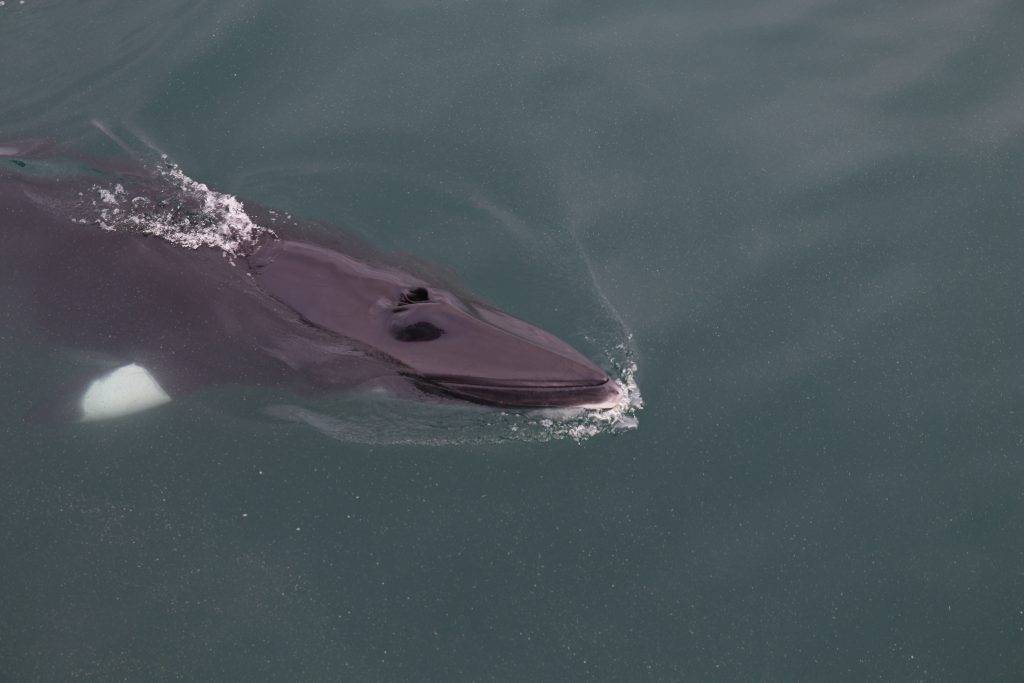

What to look out for:
- Minke whales have a very characteristic profile when surfacing, with a long, slate-grey back and a short curved dorsal fin about 2/3 of the way down
- They are the smallest member of the rorqual family, but they can still grow to be 10m long!
- Minkes are known to be curious around boats, and will sometimes come close to investigate – keep an eye out for the distinctive white bands on their pectoral fins
Humpback whale (Megaptera novaeangliae)
Once hunted intensively, there were very few humpbacks in Iceland up to about 1970. Happily, their recovery has been relatively rapid compared to many of the other great whales, and it is thought that the population here levelled off in around 2000.
Humpback whales come all the way to Iceland from their breeding grounds in the warm waters of the West Indies. Although most humpbacks only come to feed here in summer, not all individuals make the return trip south – so there is a good chance you could see some humpbacks in winter too.
Best place to see them?
- In summer they are most common off the north coast, particularly in Skjálfandi Bay where their numbers have been increasing in recent years
- Humpback whales are also frequently spotted in Faxaflói Bay
- Less is known about their winter distribution – a few whales often remain in Skjálfandi and Faxaflói, but humpbacks seem to be particularly common in Vestmannaeyjar in late winter and early spring

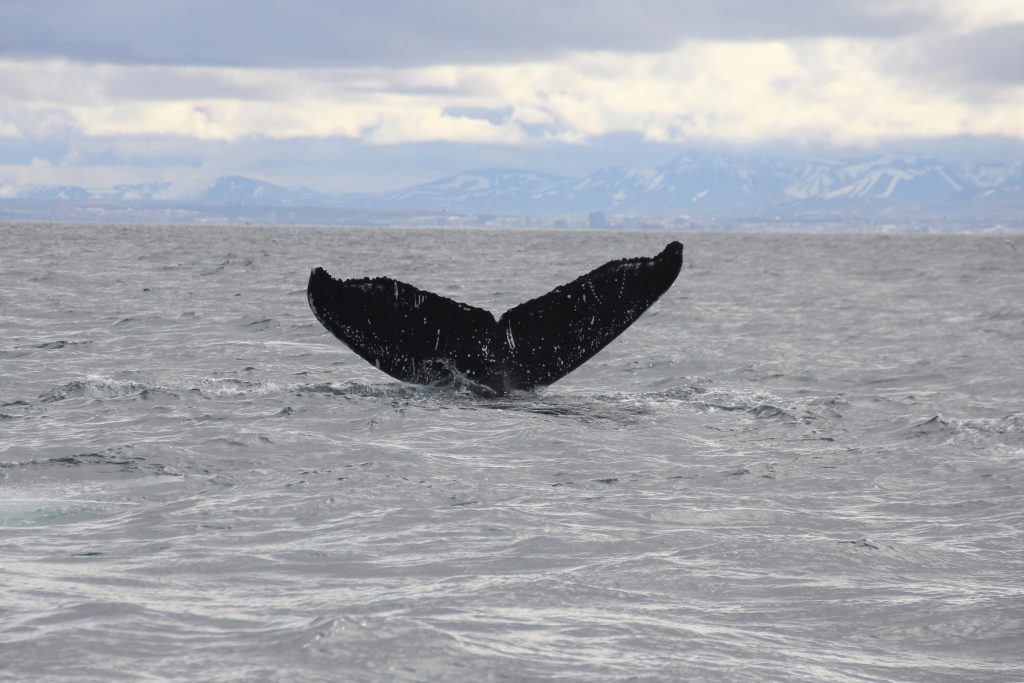
What to look out for:
- As they dive, their back arches into a characteristic ‘hump’ which gives them their name
- Each whale has a unique black-and-white pattern on the underside of their tail flukes, a bit like a fingerprint
- A big splash! Humpbacks are famous for their acrobatics, and if you’re lucky you might get to see some breaches
White-beaked dolphin (Lagenorhynchus albirostris)
Iceland receives several ‘visiting’ species of dolphins, such as bottlenose, common, and striped dolphins, but the white-beaked dolphin is one of the only dolphins resident in Icelandic waters for the whole year. They are also the most numerous dolphins in Iceland.
Best place to see them?
- White-beaked dolphins are most frequently encountered in waters off of western and especially northern Iceland
- They are one of the most common sights on whale-watching tours out of Reykjavík in summer and in winter
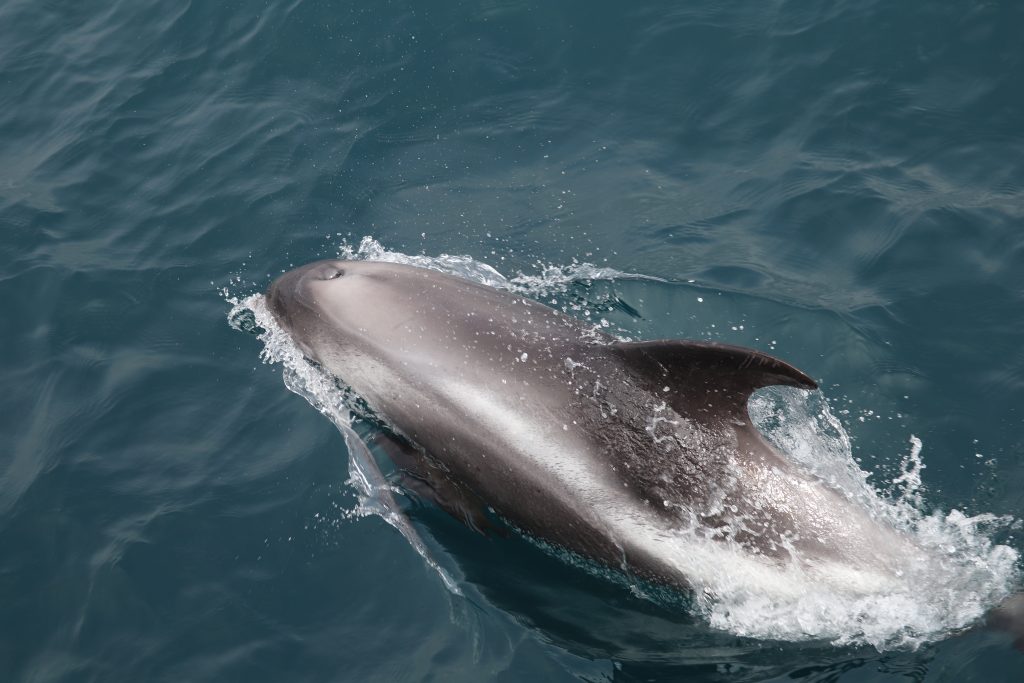
What to look out for:
- White-beaked dolphins are an acrobatic species, known to perform impressive leaps and breaches and often coming close to boats to bow-ride
- They are dark grey with distinctive white markings on their side and a relatively tall, curved dorsal fin
Killer whale (Orcinus orca)
Killer whales, or orcas, are the largest member of the dolphin family. It is thought that killer whales in Iceland feed mostly on herring, but some individuals have a more varied diet and will hunt other fish and even marine mammals.
Killer whales can be found in Iceland at any time of year. However, they have seasonal residency in different locations – which is thought to be linked to the migrations of Icelandic herring – so to see them you have to be in the right place at the right time!
Best place to see them?
- Killer whales can be seen around the Snæfellsnes peninsula.
- Vestmannaeyjar is a major herring spawning site, and killer whales can be found in this archipelago, often in large groups, from June through to August

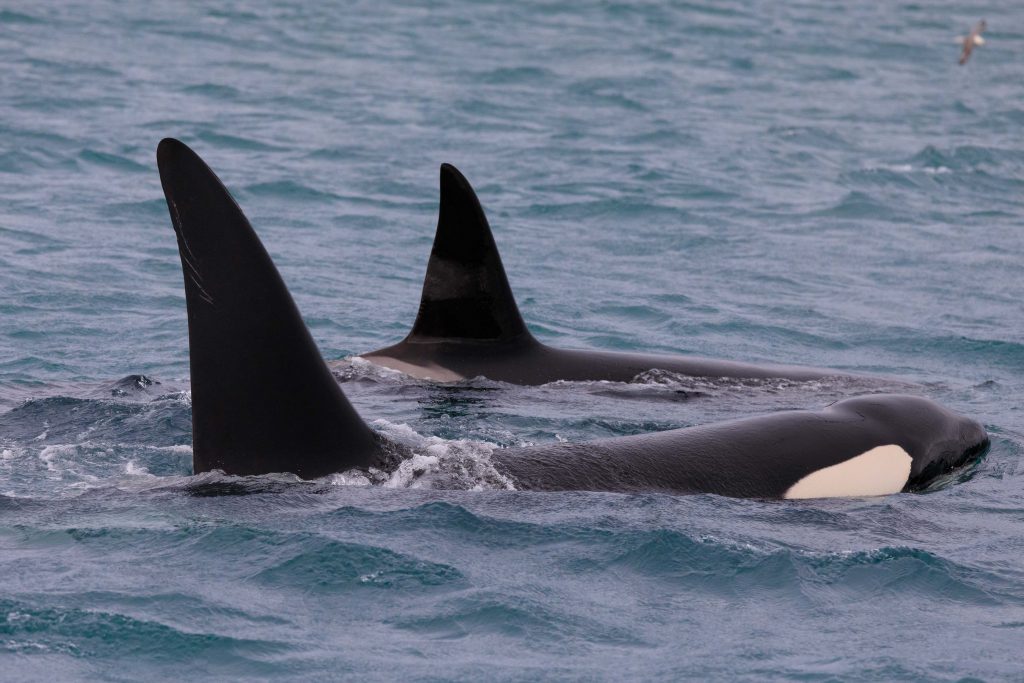
What to look out for:
- Males have a huge dorsal fin, growing up to 2m tall, which makes them fairly easy to spot even from a distance
- Killer whales live in social groups, so if you see one it is likely that others will be nearby!
- They can be very active at the surface: behaviours such as spy-hopping, breaching, and tail-slapping are common when feeding or socialising
Harbour porpoise (Phocoena phocoena)
The smallest cetacean to be found in Iceland, harbour porpoises are probably quite common – however, they are very difficult to spot! They are a shy species that typically avoid boats, and they don’t breach or bow-ride like dolphins. In grey, choppy waters they look an awful lot like waves! It takes a lot of luck and a good eye to see a harbour porpoise here.
Best place to see them?
- Nearshore waters all around Iceland, and off the west coast in particular
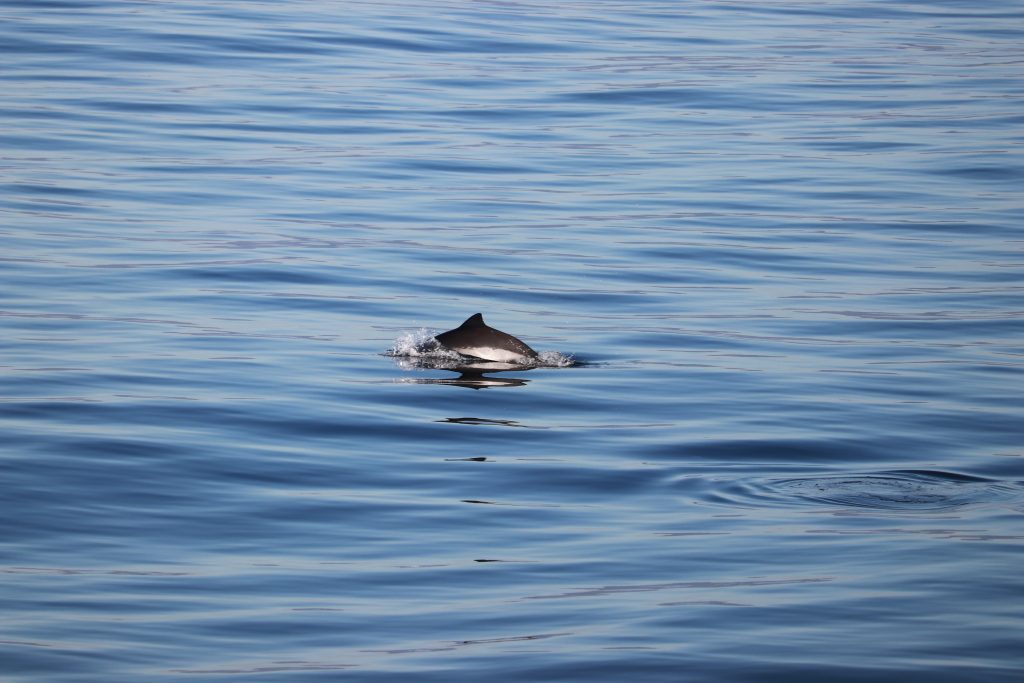
What to look out for:
- Harbour porpoises generally keep a low profile, with just their back and dorsal fin visible when swimming at the surface
- They are much smaller than dolphins and have a triangular rather than curved dorsal fin
Long-finned pilot whale (Globicephala melas)
Long-finned pilot whales are another large dolphin species. They feed at depths of 200m or more and are found most often in areas of deep water. Pilot whales do on occasion come into shallower water, which can lead to a mass stranding – something this species is unfortunately famous for.
Best place to see them?
- Most sightings of pilot whales are off the south coast of Iceland, although they are known to sometimes visit fjords in the north
- Sightings in Vestmannaeyjar in summer months have been increasing in recent years
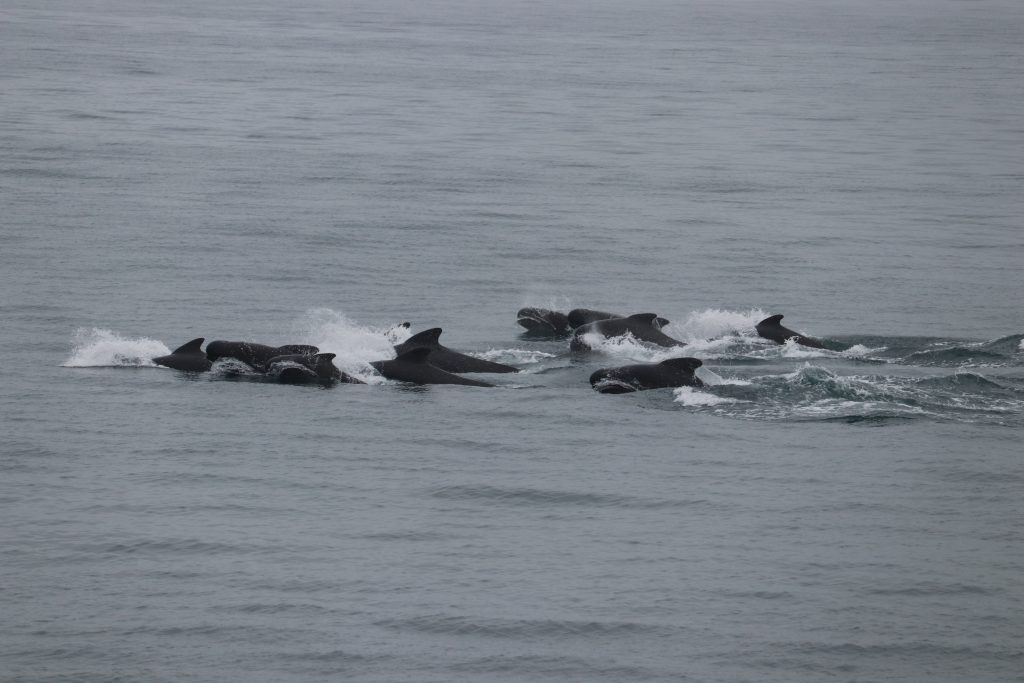
What to look out for:
- Pilot whales live in tight-knit family units that can be very large – groups of 50 or more have been spotted around Iceland
- Travelling at speed in such large groups makes a lot of splashing!
- Their dorsal fins are wide and hooked and they have distinctive round heads
Blue whales (Balaenoptera musculus)
The largest animal on Earth can be seen in Icelandic waters during summer when, like the humpbacks, they come to take advantage of the massive supply of food here. Blue whales in Iceland are part of a larger population that inhabits the whole Northeast Atlantic. Some blue whales photographed off the Icelandic coast have been resighted as far away as Svalbard, the Azores, and Mauritania!
Blue whales have not recovered quite as rapidly from commercial whaling as the other baleen whales, but sightings did increase from about 1970 until the turn of the century – particularly in the north and west.
Best place to see them?
- There are regular sightings on the west coast and the Snæfellsnes peninsula, but blue whale presence here has been decreasing since about 2000
- Over the same period of time there has been an increase in sightings in the north, in places like Skjálfandi Bay

What to look out for:
- They are in fact more grey than blue in colour, with mottled patterns on their back
- A blue whale’s blow is distinctively tall – between 10 and 12 metres high – and broad, and can be seen from very far away on a clear day
Whale watching – by land or by sea?
Going whale watching on a boat gives you the best chance of seeing whales. By getting out into more open water and into their environment you can get much closer to them, and experience whales and dolphins in their home.
But it is also possible to see whales from land, if you get lucky!
The team at Whale Wise have created a series on the best spots in Iceland to see whales from land – check it out on their Facebook or Instagram! These locations have been identified as particularly good whale watching sites based on a combination of researchers’ experiences in the field and local knowledge.
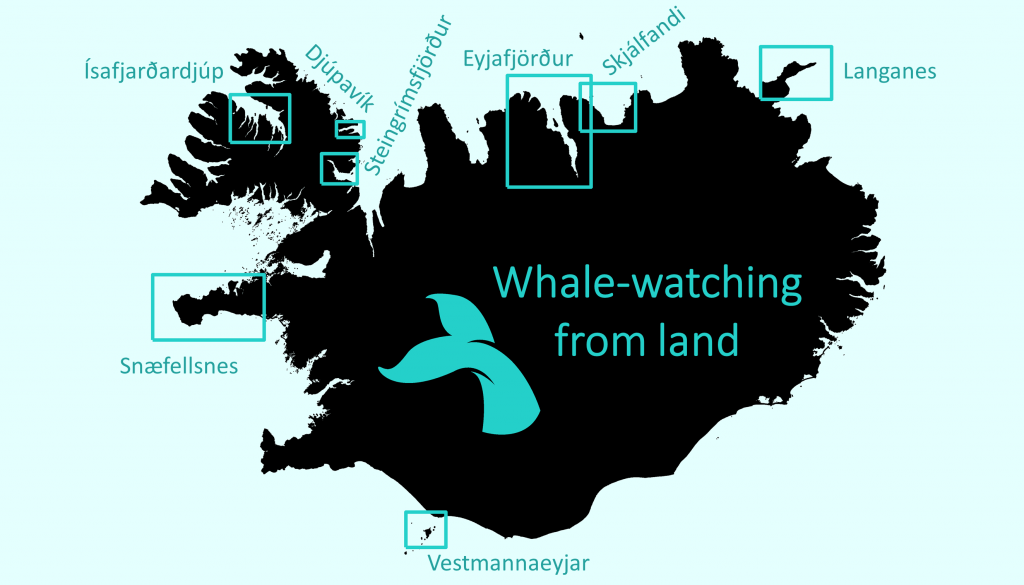
Here are some parts of Iceland where you can see whales from land. If you’re in these regions, be sure to keep one eye on the sea – you never know what will pop up! Image from Whale Wise.
The Iceland Whale Sightings Facebook group is another great resource for whale watchers and budding citizen scientists; check for any recent sightings in your area of Iceland, and share your own encounters!
Finally, remember: nature is unpredictable, and wildlife is, well, wild! Even in a cetacean hot-spot like Iceland you can never be completely sure that whales will show up when you need them to. But by following the advice in this guide, you can maximise your chances of a successful whale-watching trip – whether it’s by land or by sea.
Good luck, and happy whale watching!
Author: Eilidh O.








